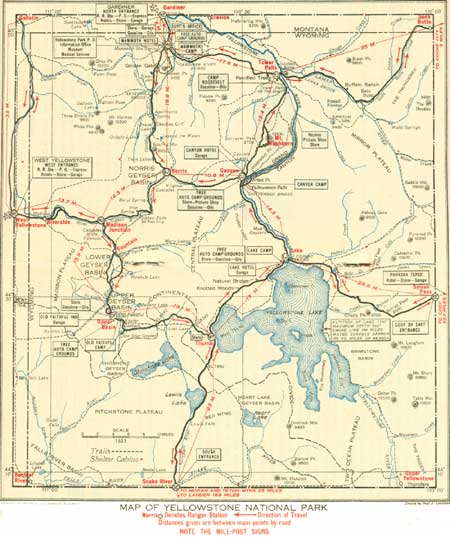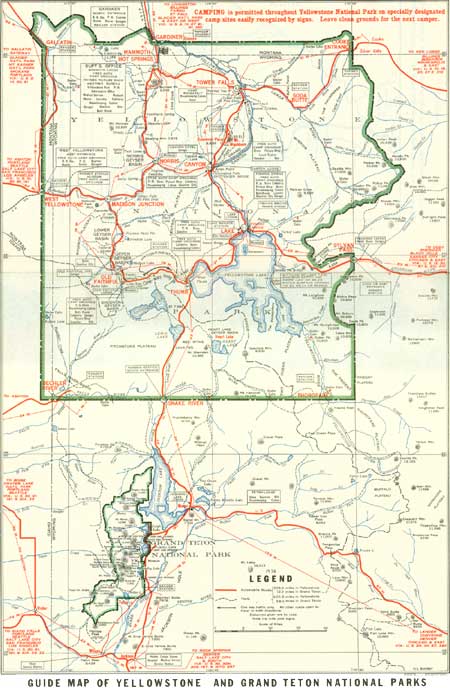|
YELLOWSTONE
Geysers of the Yellowstone National Park |

|
GEYSERS OF THE YELLOWSTONE NATIONAL PARK.
By WALTER HARVEY WEED.1
1Revised in 1921 by the National Park Service.
GENERAL STATEMENT.
The hot-water fountains, called geysers, are natural wonders that are of general as well as scientific interest. The striking manifestation which they afford of the earth's internal heat, their great beauty, and novel surroundings make them indeed worthy of that widespread interest which they arouse, and it is in the hope of gratifying a general curiosity concerning these wonderful fountains that the present paper has been written.
At the outset of this inquiry into the nature and occurrence of these natural steam engines it is necessary to exactly define what is a geyser. Briefly, a geyser is a hot spring which intermittently ejects a column of boiling water and steam. Before attempting to present such a general account of the various geyser regions of the world as will enable the reader to follow the deductions derived from a study of the occurrence and the characteristics of geysers, it may be well to present a summary of the paper.
It is believed that the facts recorded in this article show:
First. That geysers occur only in volcanic regions and in acid volcanic rocks. In Iceland and New Zealand the volcanic fires are still active.
Second. Geysers occur only along lines of drainage, on shores of lakes or other situations where meteoric waters would naturally seek the surface.
Third. Geyser waters are meteoric waters which have not penetrated to great depths, but have been heated by ascending vapors.
Fourth. The supply of heat is derived from great masses of lava slowly cooling from a state of former incandescence, heating waters, which, descending to the hot rocks, ascend as highly heated vapors.
Fifth. The intermittent spouting of geysers is due to the gradual heating of water accumulated in fissures or tubes in the rocks, the only mechanism necessary being a tube, which may or may not have local expansions or chambers.
Sixth. Geysers may originate in several ways, though most commonly produced by the opening of new waterways along fissure planes of the rocks, by a gradual eating out of a tube by ascending hot vapors.
Seventh. The thermal activity of geyser regions is not rapidly dying out. The decrease of heat is very slow, and, though changes take place from year to year, the establishment of new geysers and new hot springs offsets the decay or drying up of old vents.

|
| MAP OF YELLOWSTONE NATIONAL PARK. (from 1921 edition, click on image for an enlargement in a new window) |

|
| GUIDE MAP OF YELLOWSTONE AND GRAND TETON NATIONAL PARKS. (from 1929 edition, click on image for an enlargement in a new window) |
Attempts to solve the mysterious spouting of geysers date back to the earlier part of the present epoch of scientific research and the genius of Bunsen and Deseloiseaux was devoted to a study of the Iceland geysers as early as 1847. The most important result of their experiments and observations was a theory of geyser action, now (with slight modifications) generally accepted, but other conclusions have been proven by observations made in the Yellowstone Park to be erroneous. Although numerous visits to the geysers of Iceland by later observers led to various ingenious speculations and theories respecting geyser eruptions, the questions of geyser origin and the significance of their occurrence and other questions of broader scope were not touched upon.

|
| NEW CRATER GEYSER, NORRIS BASIN. Photograph by F. J. Haynes. |
In looking at the distribution of geysers in various parts of the world, one is quickly impressed with their great rarity. Hot springs abound in many countries, but boiling springs are characteristic only of regions of recent (that is, geologically recent) volcanic activity; only in such regions do geysers occur. Until late in the last century Iceland was the only land where geysers had been found. Less than 60 years ago they were discovered in considerable numbers in New Zealand, and since then a few others have been reported from other parts of the world. The "Geyserland" of the world is undoubtedly, however, the Yellowstone National Park, a region situated in the heart of the Rocky Mountains, at the headwaters of the Missouri and Yellowstone.

|
| CONSTANT GEYSER, NORRIS BASIN. Photograph by F. J. Haynes. |
In order to bring before the reader a general idea of the true relation of geyser vents to the surrounding topography and watercourses of the districts, a brief description of the great geyser regions of the world will be attempted. It has been my good fortune to have spent seven summers at the various geyser "basins" of the Yellowstone in connection with my duties as assistant geologist on the United States Geological Survey party under Arnold Hague. The other regions are familiar from a large series of excellent photographs, as well as through the descriptions of friends and the writings of other visitors to those countries.
| <<< Previous | <<< Contents>>> | Next >>> |
weed/sec1.htm
Last Updated: 02-Apr-2007